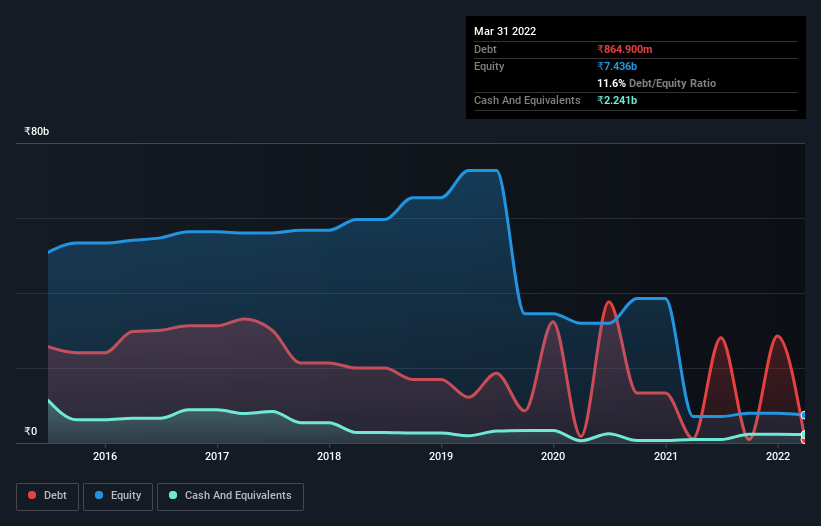Warren Buffett famously said, 'Volatility is far from synonymous with risk.' So it seems the smart money knows that debt - which is usually involved in bankruptcies - is a very important factor, when you assess how risky a company is. We note that GFL Limited (NSE:GFLLIMITED) does have debt on its balance sheet. But the more important question is: how much risk is that debt creating?
When Is Debt Dangerous?
Debt and other liabilities become risky for a business when it cannot easily fulfill those obligations, either with free cash flow or by raising capital at an attractive price. Ultimately, if the company can't fulfill its legal obligations to repay debt, shareholders could walk away with nothing. However, a more common (but still painful) scenario is that it has to raise new equity capital at a low price, thus permanently diluting shareholders. Of course, the upside of debt is that it often represents cheap capital, especially when it replaces dilution in a company with the ability to reinvest at high rates of return. When we examine debt levels, we first consider both cash and debt levels, together.
See our latest analysis for GFL
How Much Debt Does GFL Carry?
The image below, which you can click on for greater detail, shows that GFL had debt of ₹864.9m at the end of March 2022, a reduction from ₹1.14b over a year. But it also has ₹2.24b in cash to offset that, meaning it has ₹1.38b net cash.

A Look At GFL's Liabilities
We can see from the most recent balance sheet that GFL had liabilities of ₹3.94b falling due within a year, and liabilities of ₹29.0b due beyond that. On the other hand, it had cash of ₹2.24b and ₹293.0m worth of receivables due within a year. So its liabilities outweigh the sum of its cash and (near-term) receivables by ₹30.4b.
The deficiency here weighs heavily on the ₹7.06b company itself, as if a child were struggling under the weight of an enormous back-pack full of books, his sports gear, and a trumpet. So we definitely think shareholders need to watch this one closely. At the end of the day, GFL would probably need a major re-capitalization if its creditors were to demand repayment. Given that GFL has more cash than debt, we're pretty confident it can handle its debt, despite the fact that it has a lot of liabilities in total. The balance sheet is clearly the area to focus on when you are analysing debt. But it is GFL's earnings that will influence how the balance sheet holds up in the future. So when considering debt, it's definitely worth looking at the earnings trend. Click here for an interactive snapshot.
Over 12 months, GFL reported revenue of ₹7.1b, which is a gain of 562%, although it did not report any earnings before interest and tax. When it comes to revenue growth, that's like nailing the game winning 3-pointer!
So How Risky Is GFL?
Although GFL had an earnings before interest and tax (EBIT) loss over the last twelve months, it generated positive free cash flow of ₹120m. So taking that on face value, and considering the net cash situation, we don't think that the stock is too risky in the near term. The saving grace for the stock is the strong revenue growth of 562% over the last twelve months. But we genuinely do think the balance sheet is a risky. There's no doubt that we learn most about debt from the balance sheet. But ultimately, every company can contain risks that exist outside of the balance sheet. Case in point: We've spotted 3 warning signs for GFL you should be aware of, and 1 of them is potentially serious.
If, after all that, you're more interested in a fast growing company with a rock-solid balance sheet, then check out our list of net cash growth stocks without delay.
New: Manage All Your Stock Portfolios in One Place
We've created the ultimate portfolio companion for stock investors, and it's free.
• Connect an unlimited number of Portfolios and see your total in one currency
• Be alerted to new Warning Signs or Risks via email or mobile
• Track the Fair Value of your stocks
Have feedback on this article? Concerned about the content? Get in touch with us directly. Alternatively, email editorial-team (at) simplywallst.com.
This article by Simply Wall St is general in nature. We provide commentary based on historical data and analyst forecasts only using an unbiased methodology and our articles are not intended to be financial advice. It does not constitute a recommendation to buy or sell any stock, and does not take account of your objectives, or your financial situation. We aim to bring you long-term focused analysis driven by fundamental data. Note that our analysis may not factor in the latest price-sensitive company announcements or qualitative material. Simply Wall St has no position in any stocks mentioned.
About NSEI:GFLLIMITED
Excellent balance sheet and slightly overvalued.
Market Insights
Community Narratives



